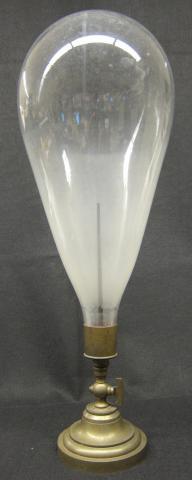Media
Fountain in Vacuo
Fountain in Vacuo
Text
Standing over two feet tall, the oblong glass globe of the fountain in vacuo looks like something out of a mad scientist’s laboratory. The apparatus, attached to a metal base with a stem and control valve, spectacularly demonstrates the concept of air pressure by creating a jet of water within the globe.
The fountain in vacuo was a common demonstration in college science halls and in community lectures during the 19th century, as it was a simple and pleasing example of pneumatics. The air within the globe would be removed using an air pump connected to the base with a tube. The control valve would then be closed, preventing any air from re-entering the vacuum. The fountain’s tube would be disconnected from the air pump and submerged in water. When the valve was released, the difference of atmospheric pressure forced water into the globe, creating an unexpected “fountain in a vacuum.”
Demonstrations like the fountain in vacuo were very popular in scientific lectures in the 19th century. The fountain itself, and apparatuses like it, were made specifically for demonstration and teaching. A researcher would have little use for a fountain in vacuo, because it did not allow for any kind of experimentation and demonstrated known principles. To the teacher, however, the fountain was an invaluable pedagogical tool, as it showed in a grand and interesting fashion an otherwise complex concept within pneumatics. Made solely for teaching, this machine shows the importance of scientific lecturing and demonstration during the 19th century.
For Further Reading:
Greenslade, Thomas B. “Pneumatics.” Instruments for Natural Philosophy. http://physics.kenyon.edu/EarlyApparatus/Titlepage/Pneumatics.html.
Turner, Gerard L'Estrange. Nineteenth-Century Scientific Instruments. London: Sotheby Publications; Berkeley: University of California Press, 1983.

